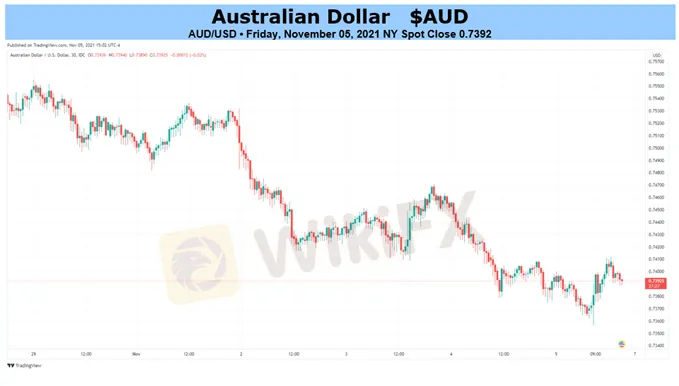简体中文
繁體中文
English
Pусский
日本語
ภาษาไทย
Tiếng Việt
Bahasa Indonesia
Español
हिन्दी
Filippiiniläinen
Français
Deutsch
Português
Türkçe
한국어
العربية
Australian Dollar Outlook: Commodities, US Dollar and RBA Weigh. Can AUD/USD Hold?
Abstract:The Australian Dollar and AU yields weighed by RBA manoeuvring Energy and metal commodities undermined AUD as USD strengthened Yields and commodities teaming up against AUD. Where to for AUD/USD?

The RBA underwhelmed market expectations at their last monetary policy meeting. The market had already witnessed the abandonment of yield curve control (YCC) prior to the meeting.
This inaction was interpreted as a potential indicator of a shift in RBA thinking around inflationary impacts. This led to possible implications for other components of monetary policy.
Turned out, the market was wrong. The RBA confirmed YCC was no longer in play but as far as bond purchasing and rate hikes go, nothing to see here.
The RBA did successfully move away from a timeline of potential rate hikes though. The time frame for a hike was aligned with maintaining YCC. While 2024 is when they see rates lifting off, they may allow for hikes in 2023 if conditions warranted it.
As a consequence, yields fell across the curve. The 10-year went from 1.98% to 1.76% as the 2-year dipped from 0.67% to 0.355%. The Aussie followed suit and went lower.
In the background, commodity markets were under pressure. Iron ore and coal in particular sustained large moves lower.
In addition, the Fed and the Bank of England met, and the biggest surprise was that UK cash rates were not hiked. This saw significant US Dollar buying, pushing the AUD/USD lower.
From here, the fate for AUD/USD appears to be caught in a 3-way tussle between yields, commodities, and the US Dollar.
Bond markets have swung wildly in anticipation of central banks stepping back from super-loose monetary policy. That perception was smashed as central banks maintained their asymmetric bias toward growth, rather than fighting inflation.
The market may or may not have over-corrected to the low side on yields, but its hard to see rates going too far north when short-end rates are anchored to the floor.
Iron ore, Australia‘s largest export, remains under sustained pressure due to soft economic data coming out of China. It traded below the equivalent of US$ 87 on China’s domestic exchange, from highs above US$ 200 earlier in the year.
Various prices tracking coal futures remain significantly below the highs seen last month. Weather in energy-vulnerable parts of the world may turn the tide on the downtrend, but it is early in the season and less likely for now.
The US Dollar continues to benefit from the heightened uncertainty between interest rates and energy markets. Further instability could see more support for ‘the big dollar’.
Looking ahead, after some business and consumer confidence numbers, the jobs data will be watched on Thursday for clues on any uptick from a partial exit from lockdown in October.
AUD/USD AGAINST AUSTRALIA 10-YEAR YIELD, COAL AND IRON ORE

Disclaimer:
The views in this article only represent the author's personal views, and do not constitute investment advice on this platform. This platform does not guarantee the accuracy, completeness and timeliness of the information in the article, and will not be liable for any loss caused by the use of or reliance on the information in the article.
Read more

Myaccount Upgrade Announcement
We are pleased to announce that STARTRADER MyAccount is scheduled for system upgrade starting at 00:00 platform time (GMT+3) on July 6, 2024, and will be completed within the same day.

Trading Hours Adjustment of Cryptocurrency Products
Trading Hours Adjustment of Cryptocurrency Products

STARTRADER Secures 4 Awards at ProFX Awards Ceremony
In an honorable moment, STARTRADER has received 4 prestigious awards at the ProFX Awards ceremony held on 31 May 2024, Queen Elizabeth 2 Hotel in Dubai, UAE.

Market Closure in June
Please be advised that the following instruments' trading hours and market session times will be affected by the upcoming June holidays.
WikiFX Broker
Latest News
High-Potential Investments: Top 10 Stocks to Watch in 2025
US Dollar Insights: Key FX Trends You Need to Know
Why Is Nvidia Making Headlines Everywhere Today?
Discover How Your Trading Personality Shapes Success
FINRA Charges UBS $1.1 Million for a Decade of False Trade Confirmations
Bitcoin in 2025: The Opportunities and Challenges Ahead
BI Apprehends Japanese Scam Leader in Manila
Big News! UK 30-Year Bond Yields Soar to 25-Year High!
SQUARED FINANCIAL: Your Friend or Foe?
Join the Event & Level Up Your Forex Journey
Currency Calculator






